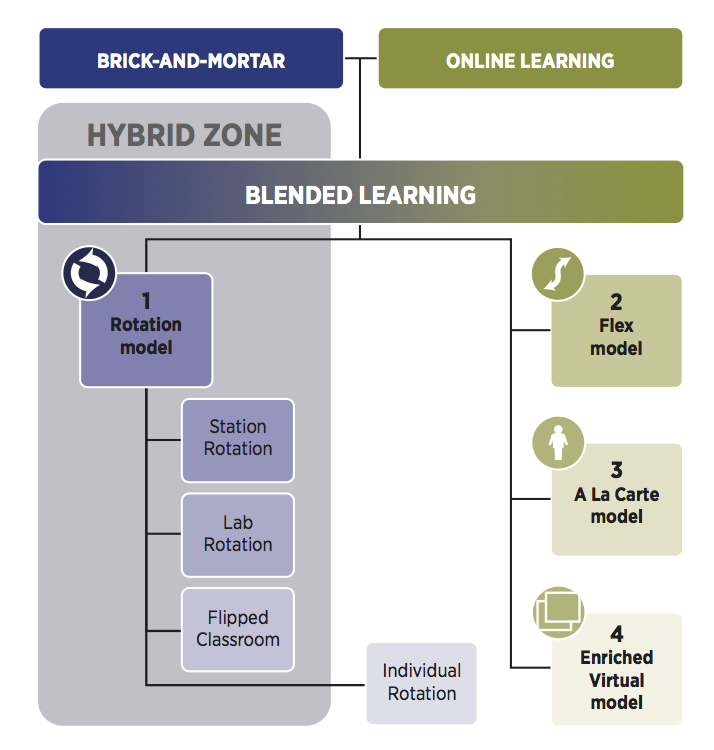By Clayton M. Christensen, Michael B. Horn, and Heather Staker
May 2013
EXECUTIVE SUMMARY
The Clayton Christensen Institute, formerly Innosight Institute, has published three papers describing the rise of K−12 blended learning—that is, formal education programs that combine online learning and brick-and-mortar schools. This fourth paper is the first to analyze blended learning through the lens of disruptive innovation theory to help people anticipate and plan for the likely effects of blended learning on the classrooms of today and schools of tomorrow. The paper includes the following sections:
Introduction to sustaining and disruptive innovation
There are two basic types of innovation—sustaining and disruptive—that follow different trajectories and lead to different results. Sustaining innovations help leading, or incumbent, organizations make better products or services that can often be sold for better profits to their best customers. They serve existing customers according to the original definition of performance— that is, according to the way the market has historically defined what’s good. A common misreading of the theory of disruptive innovation is that disruptive innovations are good and sustaining innovations are bad. This is false. Sustaining innovations are vital to a healthy and robust sector, as organizations strive to make better products or deliver better services to their best customers.
Disruptive innovations, in contrast, do not try to bring better products to existing customers in established markets. Instead, they offer a new definition of what’s good—typically they are simpler, more convenient, and less expensive products that appeal to new or less demanding customers. Over time, they improve enough to intersect with the needs of more demanding customers, thereby tranforming a sector. Examples in the paper from several industries demonstrate the classic patterns of both types of innovation.
Theory of hybrids
Often industries experience a hybrid stage when they are in the middle of a disruptive transformation. A hybrid is a combination of the new, disruptive technology with the old technology and represents a sustaining innovation relative to the old technology. For example, the automobile industry has developed several hybrid cars along its way to transitioning from gasoline-fueled engines to engines with alternative power sources. The leading companies want the virtues of both, so they have developed a sustaining innovation—hybrid cars that use both gasoline and electricity. Other industries—including earth excavators, steamships, photography, retail, and banking—have experienced a hybrid stage on their way to realizing the pure disruption. Industries create hybrids for predictable reasons, including because the business case for the purely disruptive technology is not compelling at first to industry leaders, whereas implementing a hybrid as a sustaining innovation allows incumbents to satisfy their best customers.
How to spot a hybrid
Hybrid innovations follow a distinct pattern. These are four characteristics of a hybrid:
- It includes both the old and new technology, whereas a pure disruption does not offer the old technology in its full form.
- It targets existing customers, rather than nonconsumers—that is, those whose alternative to using the new technology is nothing at all.
- It tries to do the job of the preexisting technology. As a result, the performance hurdle required to delight the existing customers is quite high because the hybrid must do the job at least as well as the incumbent product on its own, as judged by the original definition of performance. In contrast, companies that succeed at disruptive innovations generally take the capabilities of the new technology as a given and look for markets that will accept the new definition of what’s good.
- It tends to be less “foolproof ” than a disruptive innovation. It does not significantly reduce the level of wealth and/or expertise needed to purchase and operate it.
Importantly, where there is no nonconsumption in a market, a hybrid solution is the only viable option for a new technology that underperforms the old based on the original definition of performance. That means that in markets with full consumption, hybrid innovations tend to dominate instead of pure disruptions.
 Hybrid models of blended learning
Hybrid models of blended learning
In many schools, blended learning is emerging as a hybrid innovation that is a sustaining innovation relative to the traditional classroom. This hybrid form is an attempt to deliver “the best of both worlds”—that is, the advantages of online learning combined with all the benefits of the traditional classroom. In contrast, other models of blended learning appear disruptive relative to the traditional classroom. They do not include the traditional classroom in its full form; they often get their start among nonconsumers; they offer benefits that accord to a new definition of what’s good; and they tend to be more foolproof to purchase and operate.
In terms of the emerging blended-learning taxonomy, the Station Rotation, Lab Rotation, and Flipped Classroom models are following the pattern of sustaining hybrid innovations. They incorporate the main features of both the traditional classroom and online learning. The Flex, A La Carte,* Enriched Virtual, and Individual Rotation models, in contrast, are developing more disruptively relative to the traditional system.
Seeing what’s next with blended learning
The models of blended learning that follow the hybrid pattern are on a sustaining trajectory relative to the traditional classroom. They are poised to build upon and offer sustaining enhancements to the factory-based classroom system, but not disrupt it. The models that are more disruptive, however, are positioned to transform the classroom model and become the engines of change over the longer term, particularly at the secondary level. Any hybrid variety of blended learning is likely to fall by the wayside as the pure disruption becomes good enough.
When this happens, the fundamental role of brick-and-mortar schools will pivot. Schools will focus more, for example, on providing well-kept facilities that students want to attend with great face-to-face support, high-quality meals, and a range of athletic, musical, and artistic programs and will leverage the Internet for instruction.
Although traditional and hybrid classrooms are poised for disruption, we do not see brick- and-mortar schools falling by the wayside any time soon. This is because although many areas of nonconsumption exist at the classroom level—particularly in secondary schools—little nonconsumption exists at the school level in the United States. Almost every student has access to a government-funded school of some sort. We predict that hybrid schools, which combine existing schools with new classroom models, will be the dominant model of schooling in the United States in the future. But within secondary schools, the disruptive models of blended learning will substantially replace traditional classrooms over the long term. In the paper, we conclude that the models that are more disruptive—Flex, A La Carte, Enriched Virtual, and Individual Rotation—are positioned to transform the classroom model and become the engines of change over the longer term in high school and middle school, but likely not in elementary school.
Implications for education leaders
Education leaders can use the disruptive innovation lens to anticipate the effects of their efforts. Strategies that sustain the traditional model could benefit students for years to come. This path is the best fit for most classroom teachers, school leaders who have limited budgetary or architectural control over their schools, and those who want to improve upon the classrooms in which most students receive their formal education today. Other strategies that accelerate the deployment of disruptive blended-learning models will have a greater impact on replacing the classroom with a student-centric design. This path is a viable fit for school principals—often in charters but also within districts, especially in those that have moved to portfolio models— that have some autonomy with respect to budget and school architecture. Furthermore, district leaders with authority to contract with online providers, state policy leaders, philanthropists, and entrepreneurs all are in the position to play a role in bolstering disruptive innovation.
Education leaders can foster disruptive innovation in several ways, including by following these five steps:
- Create a team within the school that is autonomous from all aspects of the traditional classroom.
- Focus disruptive blended-learning models initially on areas of nonconsumption.
- When ready to expand beyond areas of nonconsumption, look for the students with less demanding performance requirements.
- Commit to protecting the fledgling disruptive project.
- Push innovation-friendly policy.
In the long term, the disruptive models of blended learning are on a path to becoming good enough to entice mainstream students from the existing system into the disruptive one in secondary schools. They introduce new benefits—or value propositions—that focus on providing individualization; universal access and equity; and productivity. Over time, as the disruptive models of blended learning improve, these new value propositions will be powerful enough to prevail over those of the traditional classroom.
Download Paper



